Organizational Change Management: A Case Study of Amazon Inc.
VerifiedAdded on 2023/06/03
|12
|3052
|167
Report
AI Summary
This report provides an in-depth analysis of organizational change management within Amazon, highlighting the company's evolution in decision-making processes and leadership styles. Initially characterized by centralized decision-making under CEO Jeff Bezos, Amazon faced challenges such as high labor turnover and decision failures, prompting a shift towards decentralization and greater stakeholder engagement. The report examines the factors influencing this change, including internal issues and the need to adapt to external business scenarios. Intervention strategies, particularly stakeholder involvement, are discussed, along with the application of Kotter's 8-Step Change Management Model to facilitate successful implementation. The report concludes by emphasizing the importance of these changes in enhancing organizational performance and fostering a more collaborative and innovative work environment within Amazon.
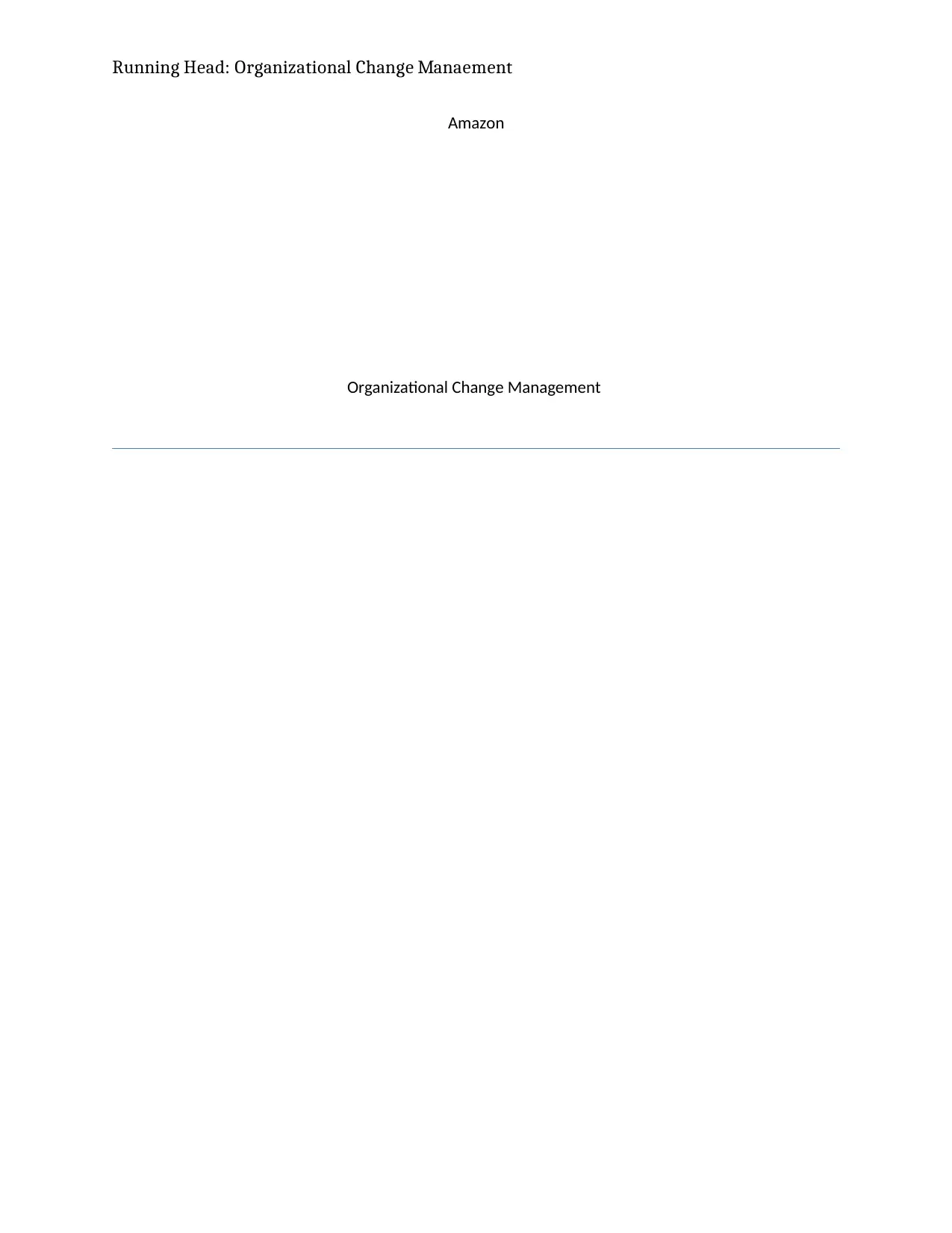
Running Head: Organizational Change Manaement
Amazon
Organizational Change Management
Amazon
Organizational Change Management
Paraphrase This Document
Need a fresh take? Get an instant paraphrase of this document with our AI Paraphraser
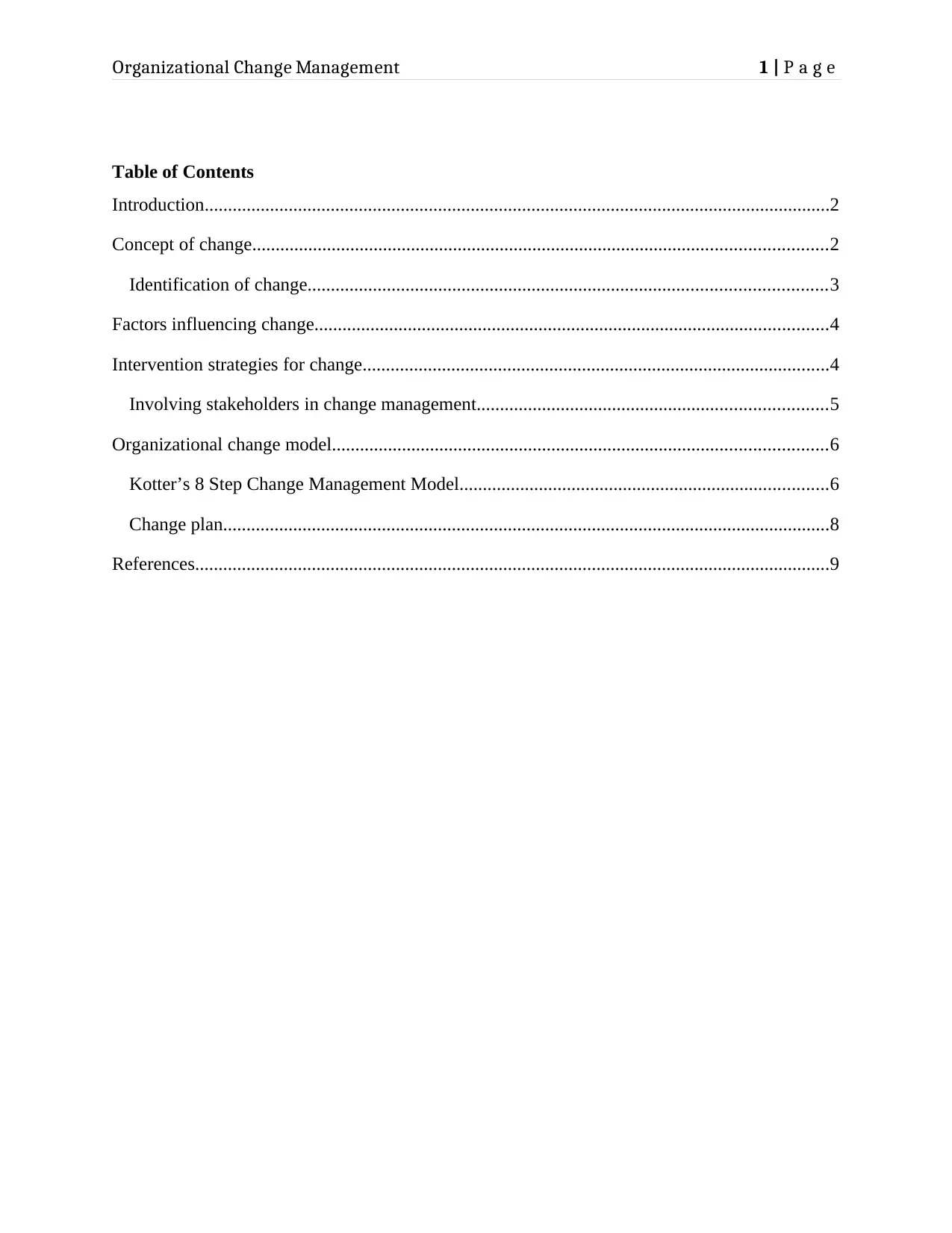
Organizational Change Management 1 | P a g e
Table of Contents
Introduction......................................................................................................................................2
Concept of change...........................................................................................................................2
Identification of change...............................................................................................................3
Factors influencing change..............................................................................................................4
Intervention strategies for change....................................................................................................4
Involving stakeholders in change management...........................................................................5
Organizational change model..........................................................................................................6
Kotter’s 8 Step Change Management Model...............................................................................6
Change plan..................................................................................................................................8
References........................................................................................................................................9
Table of Contents
Introduction......................................................................................................................................2
Concept of change...........................................................................................................................2
Identification of change...............................................................................................................3
Factors influencing change..............................................................................................................4
Intervention strategies for change....................................................................................................4
Involving stakeholders in change management...........................................................................5
Organizational change model..........................................................................................................6
Kotter’s 8 Step Change Management Model...............................................................................6
Change plan..................................................................................................................................8
References........................................................................................................................................9
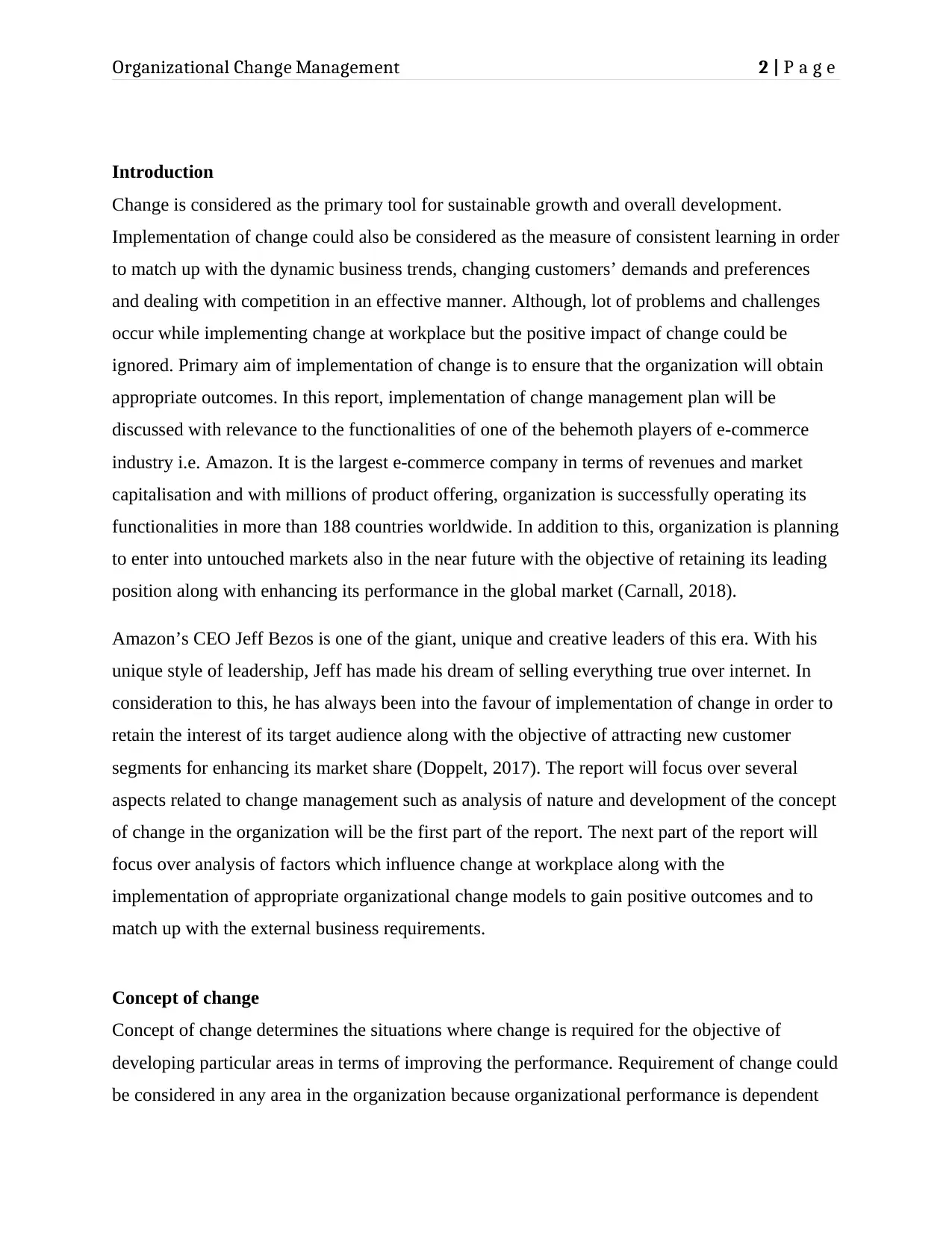
Organizational Change Management 2 | P a g e
Introduction
Change is considered as the primary tool for sustainable growth and overall development.
Implementation of change could also be considered as the measure of consistent learning in order
to match up with the dynamic business trends, changing customers’ demands and preferences
and dealing with competition in an effective manner. Although, lot of problems and challenges
occur while implementing change at workplace but the positive impact of change could be
ignored. Primary aim of implementation of change is to ensure that the organization will obtain
appropriate outcomes. In this report, implementation of change management plan will be
discussed with relevance to the functionalities of one of the behemoth players of e-commerce
industry i.e. Amazon. It is the largest e-commerce company in terms of revenues and market
capitalisation and with millions of product offering, organization is successfully operating its
functionalities in more than 188 countries worldwide. In addition to this, organization is planning
to enter into untouched markets also in the near future with the objective of retaining its leading
position along with enhancing its performance in the global market (Carnall, 2018).
Amazon’s CEO Jeff Bezos is one of the giant, unique and creative leaders of this era. With his
unique style of leadership, Jeff has made his dream of selling everything true over internet. In
consideration to this, he has always been into the favour of implementation of change in order to
retain the interest of its target audience along with the objective of attracting new customer
segments for enhancing its market share (Doppelt, 2017). The report will focus over several
aspects related to change management such as analysis of nature and development of the concept
of change in the organization will be the first part of the report. The next part of the report will
focus over analysis of factors which influence change at workplace along with the
implementation of appropriate organizational change models to gain positive outcomes and to
match up with the external business requirements.
Concept of change
Concept of change determines the situations where change is required for the objective of
developing particular areas in terms of improving the performance. Requirement of change could
be considered in any area in the organization because organizational performance is dependent
Introduction
Change is considered as the primary tool for sustainable growth and overall development.
Implementation of change could also be considered as the measure of consistent learning in order
to match up with the dynamic business trends, changing customers’ demands and preferences
and dealing with competition in an effective manner. Although, lot of problems and challenges
occur while implementing change at workplace but the positive impact of change could be
ignored. Primary aim of implementation of change is to ensure that the organization will obtain
appropriate outcomes. In this report, implementation of change management plan will be
discussed with relevance to the functionalities of one of the behemoth players of e-commerce
industry i.e. Amazon. It is the largest e-commerce company in terms of revenues and market
capitalisation and with millions of product offering, organization is successfully operating its
functionalities in more than 188 countries worldwide. In addition to this, organization is planning
to enter into untouched markets also in the near future with the objective of retaining its leading
position along with enhancing its performance in the global market (Carnall, 2018).
Amazon’s CEO Jeff Bezos is one of the giant, unique and creative leaders of this era. With his
unique style of leadership, Jeff has made his dream of selling everything true over internet. In
consideration to this, he has always been into the favour of implementation of change in order to
retain the interest of its target audience along with the objective of attracting new customer
segments for enhancing its market share (Doppelt, 2017). The report will focus over several
aspects related to change management such as analysis of nature and development of the concept
of change in the organization will be the first part of the report. The next part of the report will
focus over analysis of factors which influence change at workplace along with the
implementation of appropriate organizational change models to gain positive outcomes and to
match up with the external business requirements.
Concept of change
Concept of change determines the situations where change is required for the objective of
developing particular areas in terms of improving the performance. Requirement of change could
be considered in any area in the organization because organizational performance is dependent
⊘ This is a preview!⊘
Do you want full access?
Subscribe today to unlock all pages.

Trusted by 1+ million students worldwide
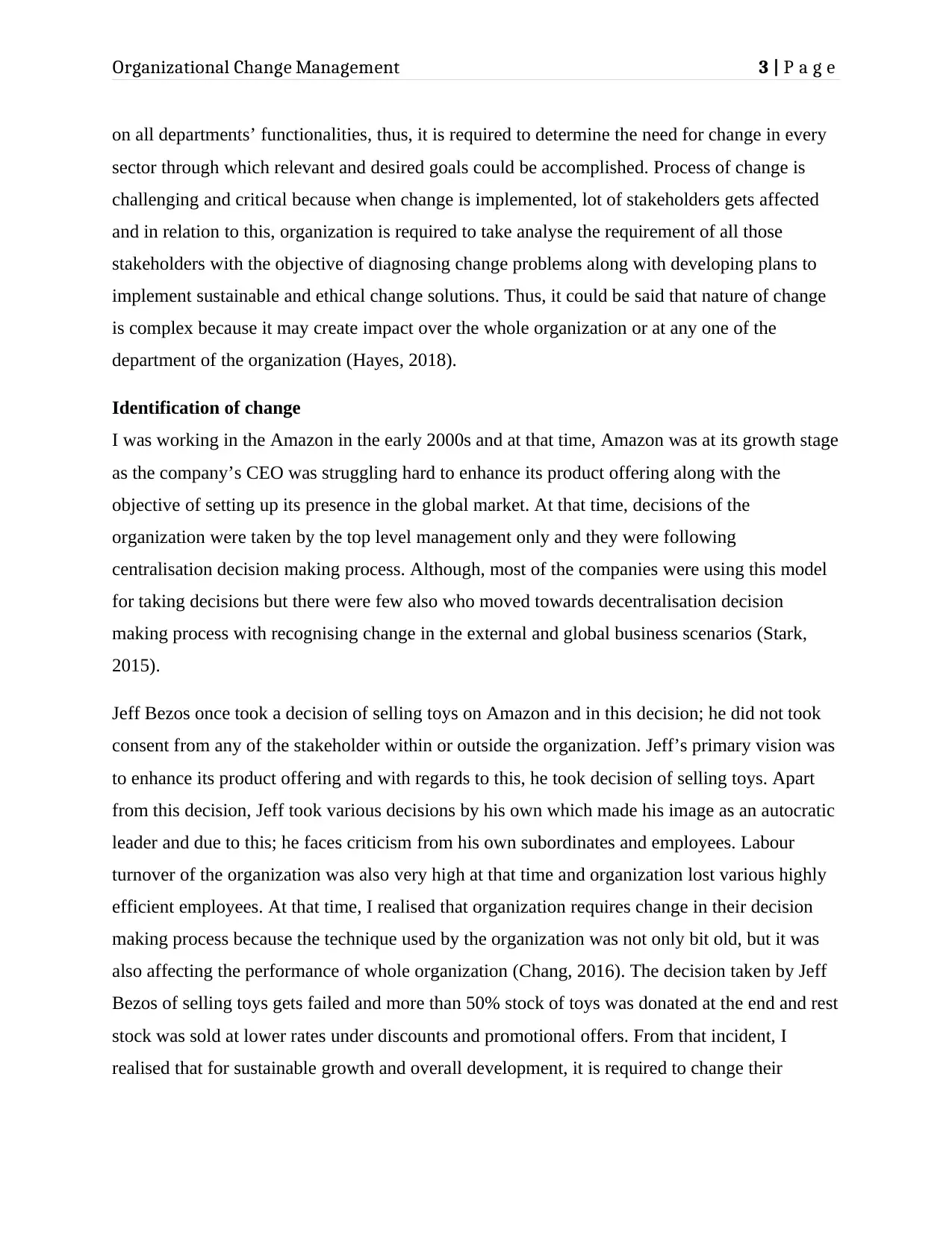
Organizational Change Management 3 | P a g e
on all departments’ functionalities, thus, it is required to determine the need for change in every
sector through which relevant and desired goals could be accomplished. Process of change is
challenging and critical because when change is implemented, lot of stakeholders gets affected
and in relation to this, organization is required to take analyse the requirement of all those
stakeholders with the objective of diagnosing change problems along with developing plans to
implement sustainable and ethical change solutions. Thus, it could be said that nature of change
is complex because it may create impact over the whole organization or at any one of the
department of the organization (Hayes, 2018).
Identification of change
I was working in the Amazon in the early 2000s and at that time, Amazon was at its growth stage
as the company’s CEO was struggling hard to enhance its product offering along with the
objective of setting up its presence in the global market. At that time, decisions of the
organization were taken by the top level management only and they were following
centralisation decision making process. Although, most of the companies were using this model
for taking decisions but there were few also who moved towards decentralisation decision
making process with recognising change in the external and global business scenarios (Stark,
2015).
Jeff Bezos once took a decision of selling toys on Amazon and in this decision; he did not took
consent from any of the stakeholder within or outside the organization. Jeff’s primary vision was
to enhance its product offering and with regards to this, he took decision of selling toys. Apart
from this decision, Jeff took various decisions by his own which made his image as an autocratic
leader and due to this; he faces criticism from his own subordinates and employees. Labour
turnover of the organization was also very high at that time and organization lost various highly
efficient employees. At that time, I realised that organization requires change in their decision
making process because the technique used by the organization was not only bit old, but it was
also affecting the performance of whole organization (Chang, 2016). The decision taken by Jeff
Bezos of selling toys gets failed and more than 50% stock of toys was donated at the end and rest
stock was sold at lower rates under discounts and promotional offers. From that incident, I
realised that for sustainable growth and overall development, it is required to change their
on all departments’ functionalities, thus, it is required to determine the need for change in every
sector through which relevant and desired goals could be accomplished. Process of change is
challenging and critical because when change is implemented, lot of stakeholders gets affected
and in relation to this, organization is required to take analyse the requirement of all those
stakeholders with the objective of diagnosing change problems along with developing plans to
implement sustainable and ethical change solutions. Thus, it could be said that nature of change
is complex because it may create impact over the whole organization or at any one of the
department of the organization (Hayes, 2018).
Identification of change
I was working in the Amazon in the early 2000s and at that time, Amazon was at its growth stage
as the company’s CEO was struggling hard to enhance its product offering along with the
objective of setting up its presence in the global market. At that time, decisions of the
organization were taken by the top level management only and they were following
centralisation decision making process. Although, most of the companies were using this model
for taking decisions but there were few also who moved towards decentralisation decision
making process with recognising change in the external and global business scenarios (Stark,
2015).
Jeff Bezos once took a decision of selling toys on Amazon and in this decision; he did not took
consent from any of the stakeholder within or outside the organization. Jeff’s primary vision was
to enhance its product offering and with regards to this, he took decision of selling toys. Apart
from this decision, Jeff took various decisions by his own which made his image as an autocratic
leader and due to this; he faces criticism from his own subordinates and employees. Labour
turnover of the organization was also very high at that time and organization lost various highly
efficient employees. At that time, I realised that organization requires change in their decision
making process because the technique used by the organization was not only bit old, but it was
also affecting the performance of whole organization (Chang, 2016). The decision taken by Jeff
Bezos of selling toys gets failed and more than 50% stock of toys was donated at the end and rest
stock was sold at lower rates under discounts and promotional offers. From that incident, I
realised that for sustainable growth and overall development, it is required to change their
Paraphrase This Document
Need a fresh take? Get an instant paraphrase of this document with our AI Paraphraser
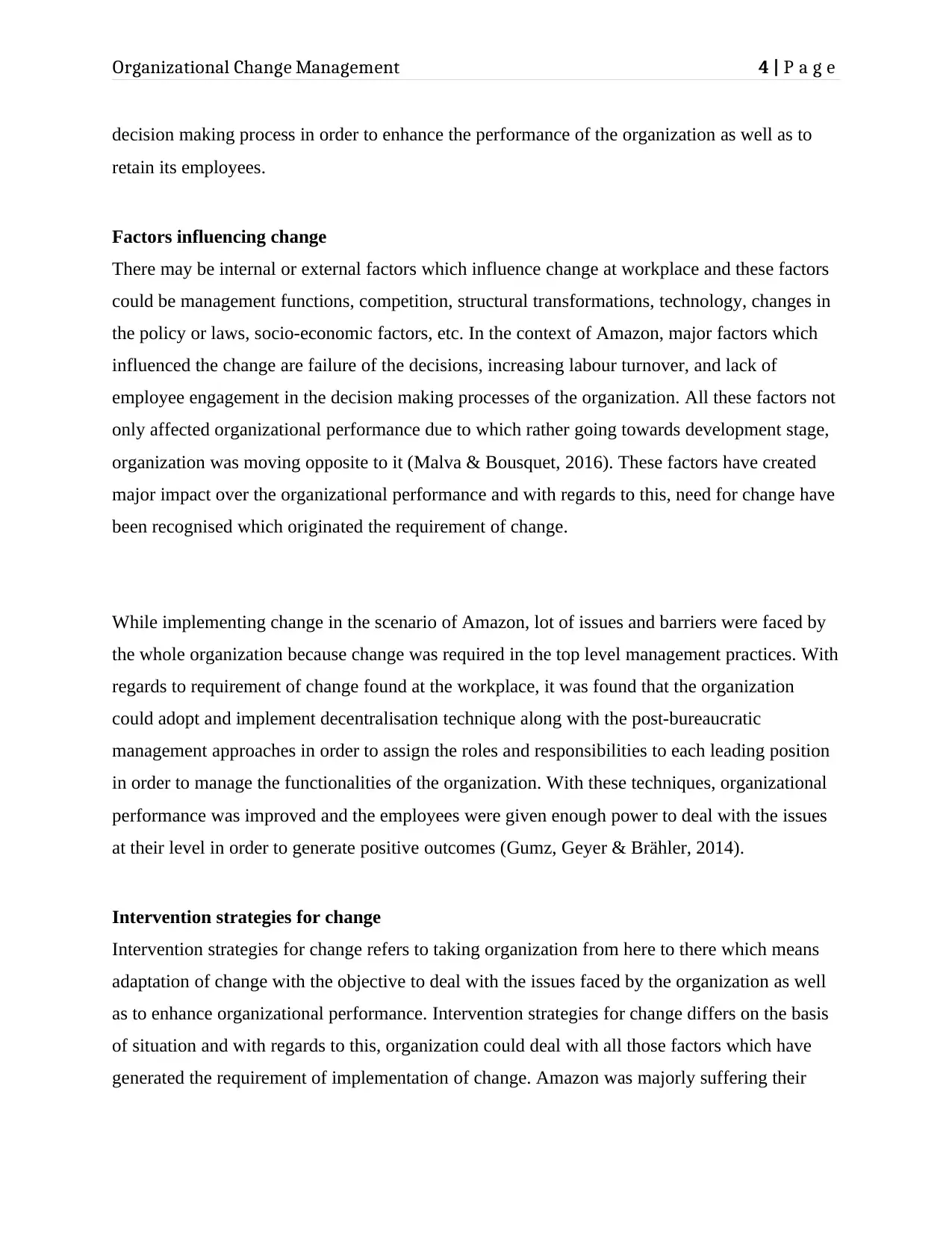
Organizational Change Management 4 | P a g e
decision making process in order to enhance the performance of the organization as well as to
retain its employees.
Factors influencing change
There may be internal or external factors which influence change at workplace and these factors
could be management functions, competition, structural transformations, technology, changes in
the policy or laws, socio-economic factors, etc. In the context of Amazon, major factors which
influenced the change are failure of the decisions, increasing labour turnover, and lack of
employee engagement in the decision making processes of the organization. All these factors not
only affected organizational performance due to which rather going towards development stage,
organization was moving opposite to it (Malva & Bousquet, 2016). These factors have created
major impact over the organizational performance and with regards to this, need for change have
been recognised which originated the requirement of change.
While implementing change in the scenario of Amazon, lot of issues and barriers were faced by
the whole organization because change was required in the top level management practices. With
regards to requirement of change found at the workplace, it was found that the organization
could adopt and implement decentralisation technique along with the post-bureaucratic
management approaches in order to assign the roles and responsibilities to each leading position
in order to manage the functionalities of the organization. With these techniques, organizational
performance was improved and the employees were given enough power to deal with the issues
at their level in order to generate positive outcomes (Gumz, Geyer & Brähler, 2014).
Intervention strategies for change
Intervention strategies for change refers to taking organization from here to there which means
adaptation of change with the objective to deal with the issues faced by the organization as well
as to enhance organizational performance. Intervention strategies for change differs on the basis
of situation and with regards to this, organization could deal with all those factors which have
generated the requirement of implementation of change. Amazon was majorly suffering their
decision making process in order to enhance the performance of the organization as well as to
retain its employees.
Factors influencing change
There may be internal or external factors which influence change at workplace and these factors
could be management functions, competition, structural transformations, technology, changes in
the policy or laws, socio-economic factors, etc. In the context of Amazon, major factors which
influenced the change are failure of the decisions, increasing labour turnover, and lack of
employee engagement in the decision making processes of the organization. All these factors not
only affected organizational performance due to which rather going towards development stage,
organization was moving opposite to it (Malva & Bousquet, 2016). These factors have created
major impact over the organizational performance and with regards to this, need for change have
been recognised which originated the requirement of change.
While implementing change in the scenario of Amazon, lot of issues and barriers were faced by
the whole organization because change was required in the top level management practices. With
regards to requirement of change found at the workplace, it was found that the organization
could adopt and implement decentralisation technique along with the post-bureaucratic
management approaches in order to assign the roles and responsibilities to each leading position
in order to manage the functionalities of the organization. With these techniques, organizational
performance was improved and the employees were given enough power to deal with the issues
at their level in order to generate positive outcomes (Gumz, Geyer & Brähler, 2014).
Intervention strategies for change
Intervention strategies for change refers to taking organization from here to there which means
adaptation of change with the objective to deal with the issues faced by the organization as well
as to enhance organizational performance. Intervention strategies for change differs on the basis
of situation and with regards to this, organization could deal with all those factors which have
generated the requirement of implementation of change. Amazon was majorly suffering their
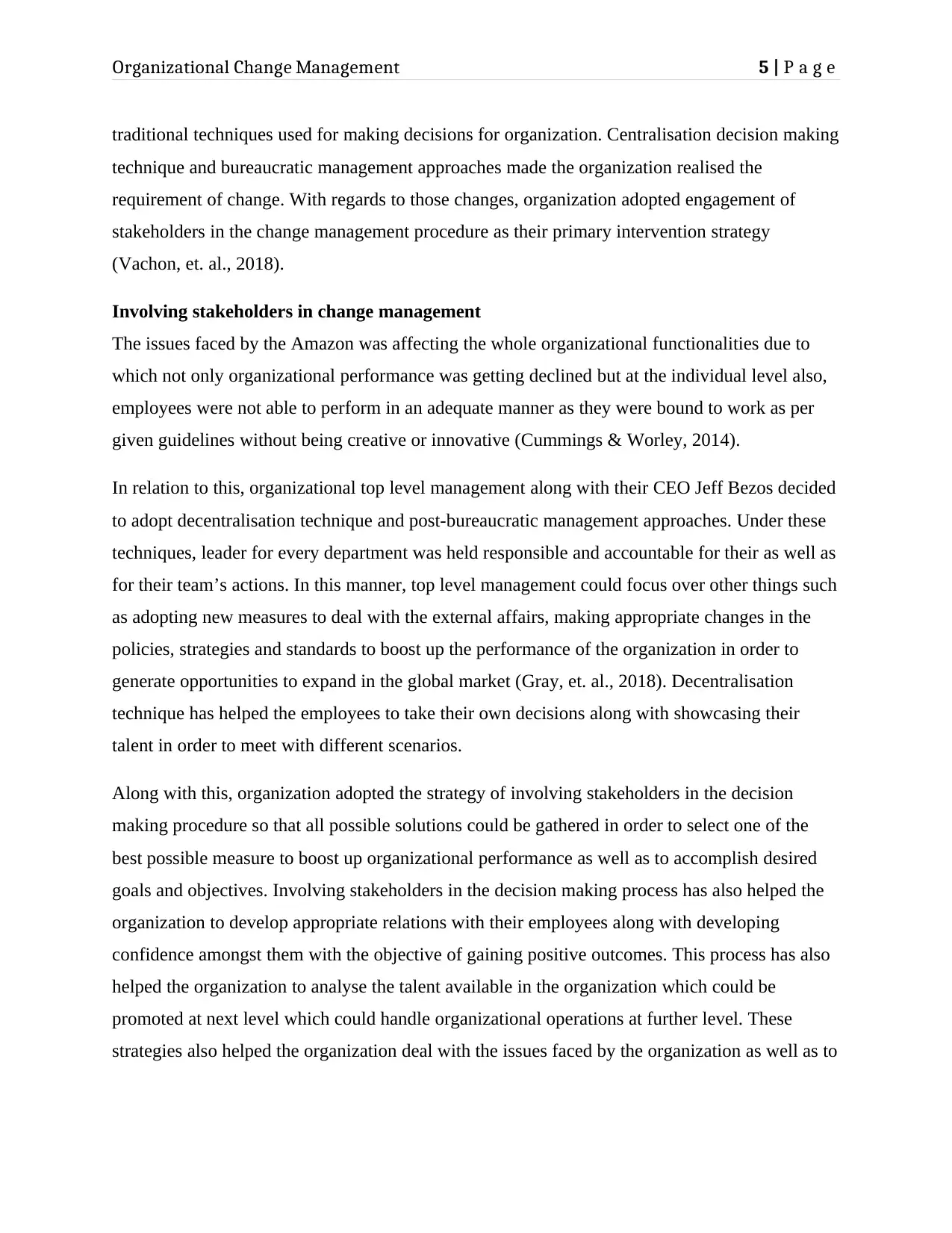
Organizational Change Management 5 | P a g e
traditional techniques used for making decisions for organization. Centralisation decision making
technique and bureaucratic management approaches made the organization realised the
requirement of change. With regards to those changes, organization adopted engagement of
stakeholders in the change management procedure as their primary intervention strategy
(Vachon, et. al., 2018).
Involving stakeholders in change management
The issues faced by the Amazon was affecting the whole organizational functionalities due to
which not only organizational performance was getting declined but at the individual level also,
employees were not able to perform in an adequate manner as they were bound to work as per
given guidelines without being creative or innovative (Cummings & Worley, 2014).
In relation to this, organizational top level management along with their CEO Jeff Bezos decided
to adopt decentralisation technique and post-bureaucratic management approaches. Under these
techniques, leader for every department was held responsible and accountable for their as well as
for their team’s actions. In this manner, top level management could focus over other things such
as adopting new measures to deal with the external affairs, making appropriate changes in the
policies, strategies and standards to boost up the performance of the organization in order to
generate opportunities to expand in the global market (Gray, et. al., 2018). Decentralisation
technique has helped the employees to take their own decisions along with showcasing their
talent in order to meet with different scenarios.
Along with this, organization adopted the strategy of involving stakeholders in the decision
making procedure so that all possible solutions could be gathered in order to select one of the
best possible measure to boost up organizational performance as well as to accomplish desired
goals and objectives. Involving stakeholders in the decision making process has also helped the
organization to develop appropriate relations with their employees along with developing
confidence amongst them with the objective of gaining positive outcomes. This process has also
helped the organization to analyse the talent available in the organization which could be
promoted at next level which could handle organizational operations at further level. These
strategies also helped the organization deal with the issues faced by the organization as well as to
traditional techniques used for making decisions for organization. Centralisation decision making
technique and bureaucratic management approaches made the organization realised the
requirement of change. With regards to those changes, organization adopted engagement of
stakeholders in the change management procedure as their primary intervention strategy
(Vachon, et. al., 2018).
Involving stakeholders in change management
The issues faced by the Amazon was affecting the whole organizational functionalities due to
which not only organizational performance was getting declined but at the individual level also,
employees were not able to perform in an adequate manner as they were bound to work as per
given guidelines without being creative or innovative (Cummings & Worley, 2014).
In relation to this, organizational top level management along with their CEO Jeff Bezos decided
to adopt decentralisation technique and post-bureaucratic management approaches. Under these
techniques, leader for every department was held responsible and accountable for their as well as
for their team’s actions. In this manner, top level management could focus over other things such
as adopting new measures to deal with the external affairs, making appropriate changes in the
policies, strategies and standards to boost up the performance of the organization in order to
generate opportunities to expand in the global market (Gray, et. al., 2018). Decentralisation
technique has helped the employees to take their own decisions along with showcasing their
talent in order to meet with different scenarios.
Along with this, organization adopted the strategy of involving stakeholders in the decision
making procedure so that all possible solutions could be gathered in order to select one of the
best possible measure to boost up organizational performance as well as to accomplish desired
goals and objectives. Involving stakeholders in the decision making process has also helped the
organization to develop appropriate relations with their employees along with developing
confidence amongst them with the objective of gaining positive outcomes. This process has also
helped the organization to analyse the talent available in the organization which could be
promoted at next level which could handle organizational operations at further level. These
strategies also helped the organization deal with the issues faced by the organization as well as to
⊘ This is a preview!⊘
Do you want full access?
Subscribe today to unlock all pages.

Trusted by 1+ million students worldwide
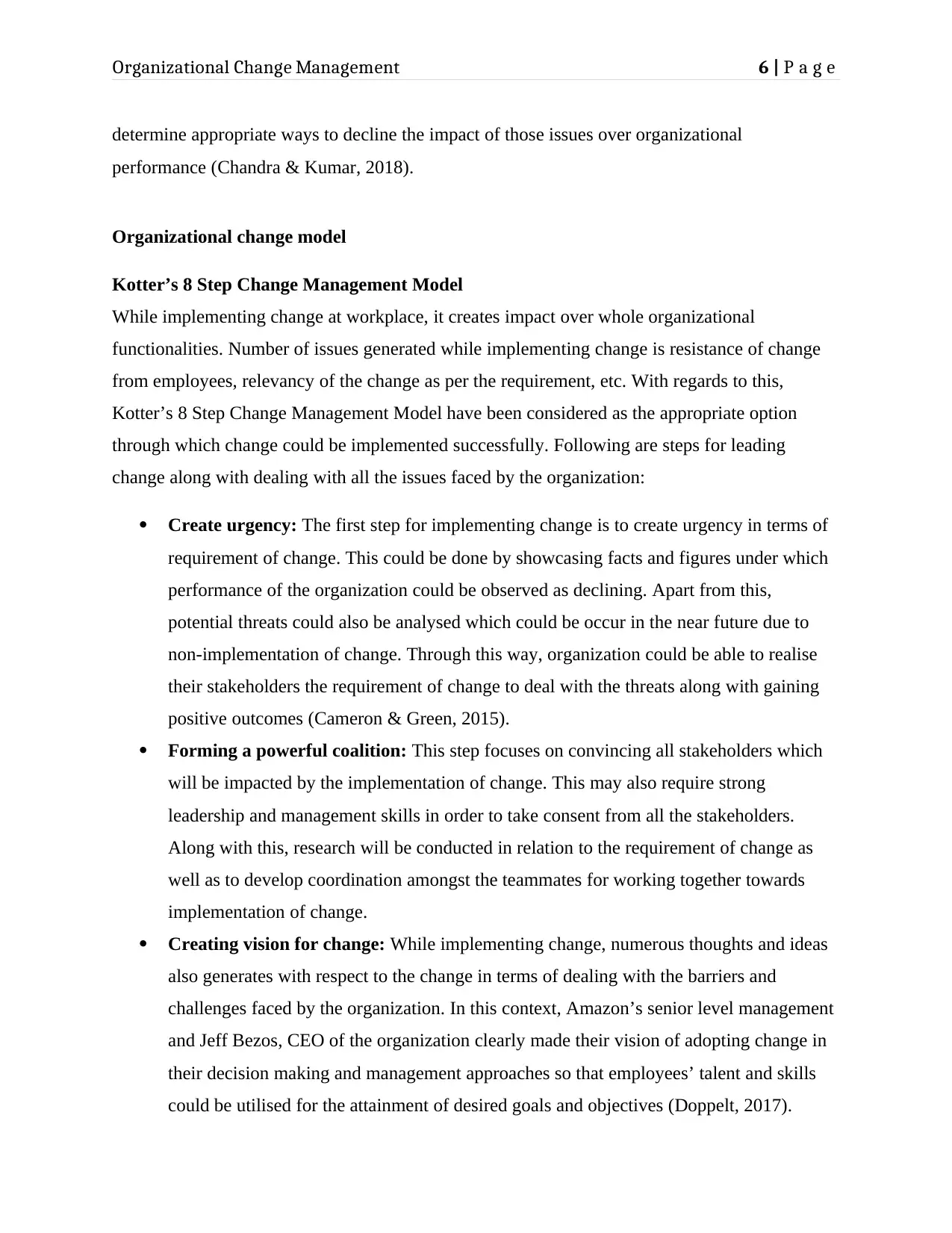
Organizational Change Management 6 | P a g e
determine appropriate ways to decline the impact of those issues over organizational
performance (Chandra & Kumar, 2018).
Organizational change model
Kotter’s 8 Step Change Management Model
While implementing change at workplace, it creates impact over whole organizational
functionalities. Number of issues generated while implementing change is resistance of change
from employees, relevancy of the change as per the requirement, etc. With regards to this,
Kotter’s 8 Step Change Management Model have been considered as the appropriate option
through which change could be implemented successfully. Following are steps for leading
change along with dealing with all the issues faced by the organization:
Create urgency: The first step for implementing change is to create urgency in terms of
requirement of change. This could be done by showcasing facts and figures under which
performance of the organization could be observed as declining. Apart from this,
potential threats could also be analysed which could be occur in the near future due to
non-implementation of change. Through this way, organization could be able to realise
their stakeholders the requirement of change to deal with the threats along with gaining
positive outcomes (Cameron & Green, 2015).
Forming a powerful coalition: This step focuses on convincing all stakeholders which
will be impacted by the implementation of change. This may also require strong
leadership and management skills in order to take consent from all the stakeholders.
Along with this, research will be conducted in relation to the requirement of change as
well as to develop coordination amongst the teammates for working together towards
implementation of change.
Creating vision for change: While implementing change, numerous thoughts and ideas
also generates with respect to the change in terms of dealing with the barriers and
challenges faced by the organization. In this context, Amazon’s senior level management
and Jeff Bezos, CEO of the organization clearly made their vision of adopting change in
their decision making and management approaches so that employees’ talent and skills
could be utilised for the attainment of desired goals and objectives (Doppelt, 2017).
determine appropriate ways to decline the impact of those issues over organizational
performance (Chandra & Kumar, 2018).
Organizational change model
Kotter’s 8 Step Change Management Model
While implementing change at workplace, it creates impact over whole organizational
functionalities. Number of issues generated while implementing change is resistance of change
from employees, relevancy of the change as per the requirement, etc. With regards to this,
Kotter’s 8 Step Change Management Model have been considered as the appropriate option
through which change could be implemented successfully. Following are steps for leading
change along with dealing with all the issues faced by the organization:
Create urgency: The first step for implementing change is to create urgency in terms of
requirement of change. This could be done by showcasing facts and figures under which
performance of the organization could be observed as declining. Apart from this,
potential threats could also be analysed which could be occur in the near future due to
non-implementation of change. Through this way, organization could be able to realise
their stakeholders the requirement of change to deal with the threats along with gaining
positive outcomes (Cameron & Green, 2015).
Forming a powerful coalition: This step focuses on convincing all stakeholders which
will be impacted by the implementation of change. This may also require strong
leadership and management skills in order to take consent from all the stakeholders.
Along with this, research will be conducted in relation to the requirement of change as
well as to develop coordination amongst the teammates for working together towards
implementation of change.
Creating vision for change: While implementing change, numerous thoughts and ideas
also generates with respect to the change in terms of dealing with the barriers and
challenges faced by the organization. In this context, Amazon’s senior level management
and Jeff Bezos, CEO of the organization clearly made their vision of adopting change in
their decision making and management approaches so that employees’ talent and skills
could be utilised for the attainment of desired goals and objectives (Doppelt, 2017).
Paraphrase This Document
Need a fresh take? Get an instant paraphrase of this document with our AI Paraphraser
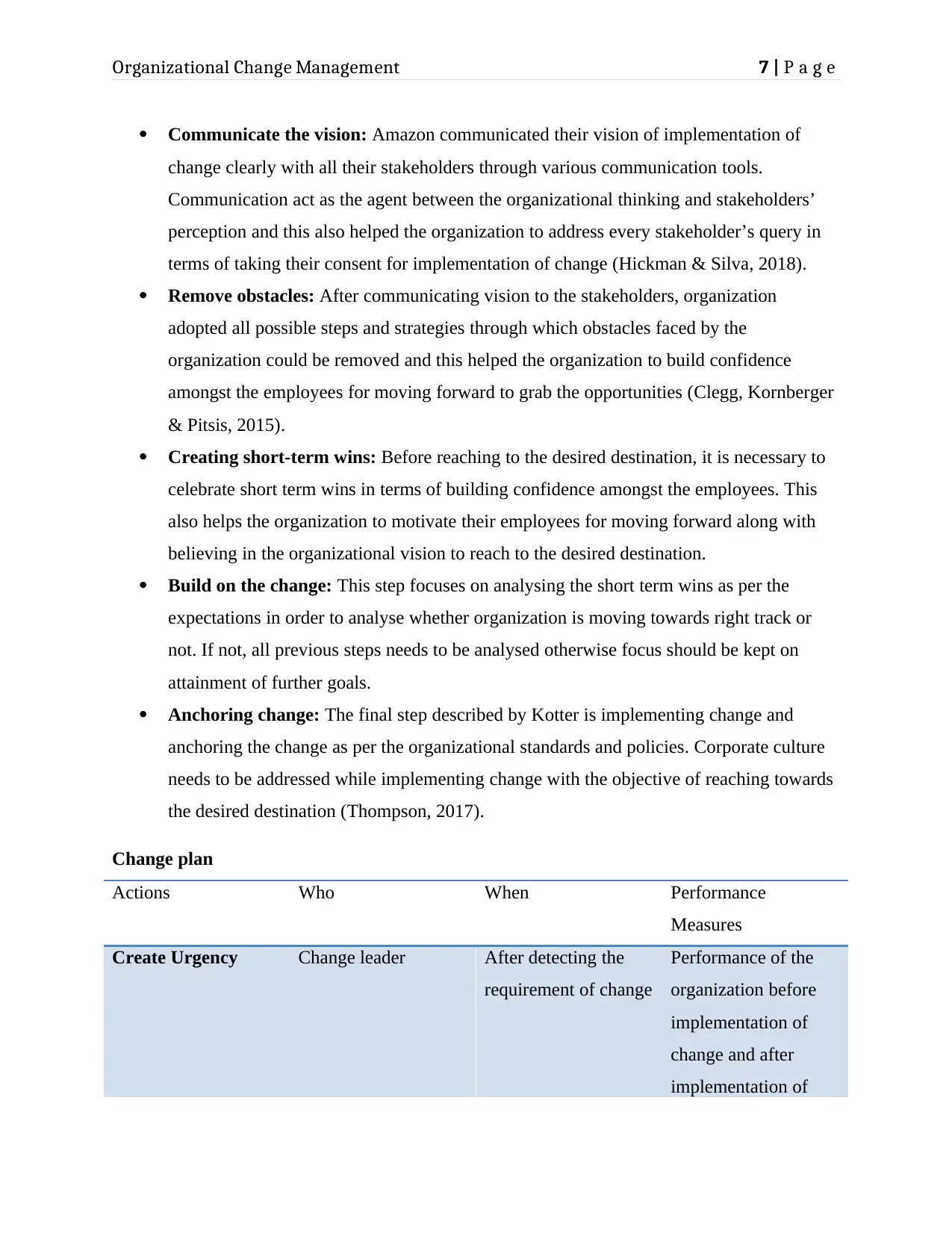
Organizational Change Management 7 | P a g e
Communicate the vision: Amazon communicated their vision of implementation of
change clearly with all their stakeholders through various communication tools.
Communication act as the agent between the organizational thinking and stakeholders’
perception and this also helped the organization to address every stakeholder’s query in
terms of taking their consent for implementation of change (Hickman & Silva, 2018).
Remove obstacles: After communicating vision to the stakeholders, organization
adopted all possible steps and strategies through which obstacles faced by the
organization could be removed and this helped the organization to build confidence
amongst the employees for moving forward to grab the opportunities (Clegg, Kornberger
& Pitsis, 2015).
Creating short-term wins: Before reaching to the desired destination, it is necessary to
celebrate short term wins in terms of building confidence amongst the employees. This
also helps the organization to motivate their employees for moving forward along with
believing in the organizational vision to reach to the desired destination.
Build on the change: This step focuses on analysing the short term wins as per the
expectations in order to analyse whether organization is moving towards right track or
not. If not, all previous steps needs to be analysed otherwise focus should be kept on
attainment of further goals.
Anchoring change: The final step described by Kotter is implementing change and
anchoring the change as per the organizational standards and policies. Corporate culture
needs to be addressed while implementing change with the objective of reaching towards
the desired destination (Thompson, 2017).
Change plan
Actions Who When Performance
Measures
Create Urgency Change leader After detecting the
requirement of change
Performance of the
organization before
implementation of
change and after
implementation of
Communicate the vision: Amazon communicated their vision of implementation of
change clearly with all their stakeholders through various communication tools.
Communication act as the agent between the organizational thinking and stakeholders’
perception and this also helped the organization to address every stakeholder’s query in
terms of taking their consent for implementation of change (Hickman & Silva, 2018).
Remove obstacles: After communicating vision to the stakeholders, organization
adopted all possible steps and strategies through which obstacles faced by the
organization could be removed and this helped the organization to build confidence
amongst the employees for moving forward to grab the opportunities (Clegg, Kornberger
& Pitsis, 2015).
Creating short-term wins: Before reaching to the desired destination, it is necessary to
celebrate short term wins in terms of building confidence amongst the employees. This
also helps the organization to motivate their employees for moving forward along with
believing in the organizational vision to reach to the desired destination.
Build on the change: This step focuses on analysing the short term wins as per the
expectations in order to analyse whether organization is moving towards right track or
not. If not, all previous steps needs to be analysed otherwise focus should be kept on
attainment of further goals.
Anchoring change: The final step described by Kotter is implementing change and
anchoring the change as per the organizational standards and policies. Corporate culture
needs to be addressed while implementing change with the objective of reaching towards
the desired destination (Thompson, 2017).
Change plan
Actions Who When Performance
Measures
Create Urgency Change leader After detecting the
requirement of change
Performance of the
organization before
implementation of
change and after
implementation of
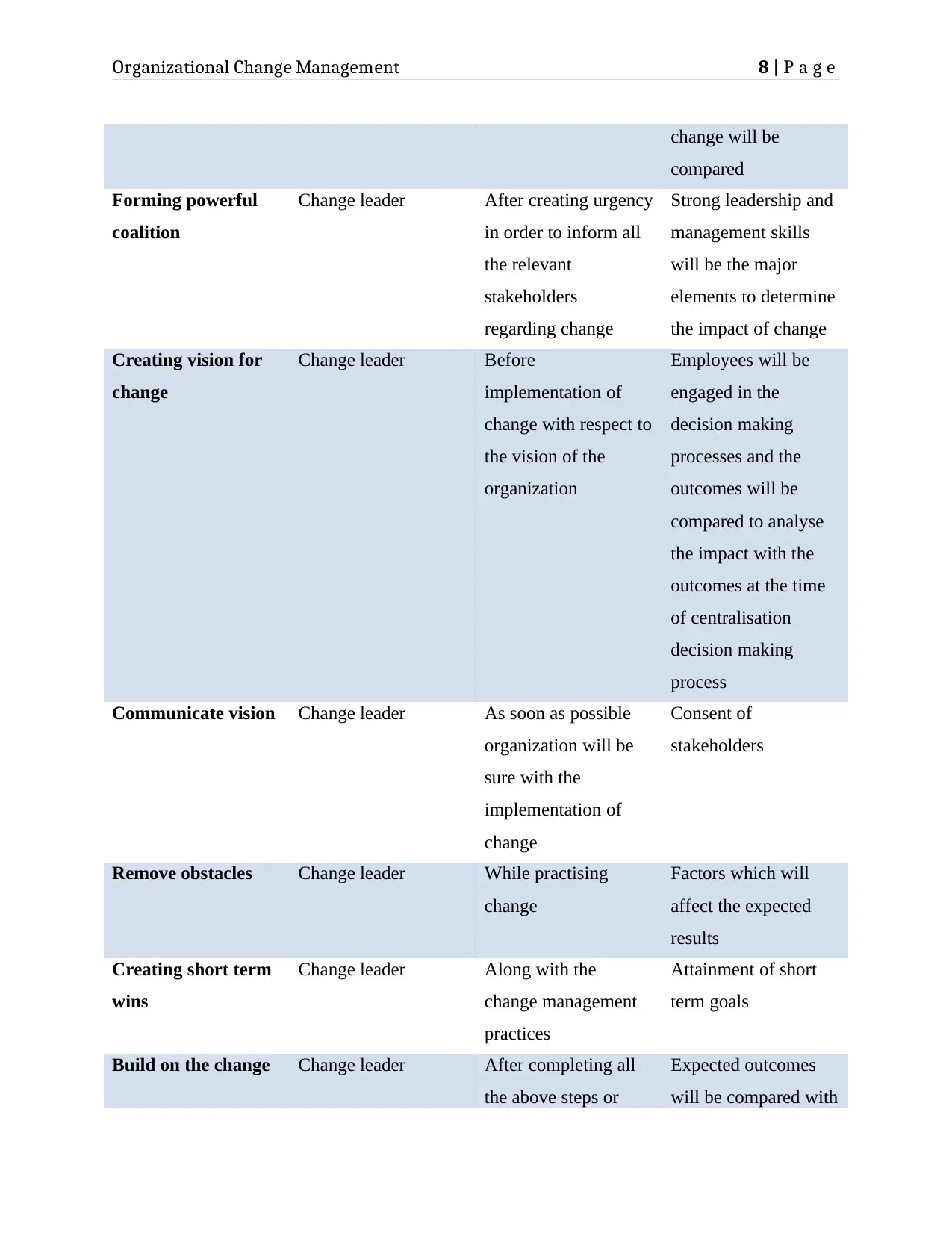
Organizational Change Management 8 | P a g e
change will be
compared
Forming powerful
coalition
Change leader After creating urgency
in order to inform all
the relevant
stakeholders
regarding change
Strong leadership and
management skills
will be the major
elements to determine
the impact of change
Creating vision for
change
Change leader Before
implementation of
change with respect to
the vision of the
organization
Employees will be
engaged in the
decision making
processes and the
outcomes will be
compared to analyse
the impact with the
outcomes at the time
of centralisation
decision making
process
Communicate vision Change leader As soon as possible
organization will be
sure with the
implementation of
change
Consent of
stakeholders
Remove obstacles Change leader While practising
change
Factors which will
affect the expected
results
Creating short term
wins
Change leader Along with the
change management
practices
Attainment of short
term goals
Build on the change Change leader After completing all
the above steps or
Expected outcomes
will be compared with
change will be
compared
Forming powerful
coalition
Change leader After creating urgency
in order to inform all
the relevant
stakeholders
regarding change
Strong leadership and
management skills
will be the major
elements to determine
the impact of change
Creating vision for
change
Change leader Before
implementation of
change with respect to
the vision of the
organization
Employees will be
engaged in the
decision making
processes and the
outcomes will be
compared to analyse
the impact with the
outcomes at the time
of centralisation
decision making
process
Communicate vision Change leader As soon as possible
organization will be
sure with the
implementation of
change
Consent of
stakeholders
Remove obstacles Change leader While practising
change
Factors which will
affect the expected
results
Creating short term
wins
Change leader Along with the
change management
practices
Attainment of short
term goals
Build on the change Change leader After completing all
the above steps or
Expected outcomes
will be compared with
⊘ This is a preview!⊘
Do you want full access?
Subscribe today to unlock all pages.

Trusted by 1+ million students worldwide
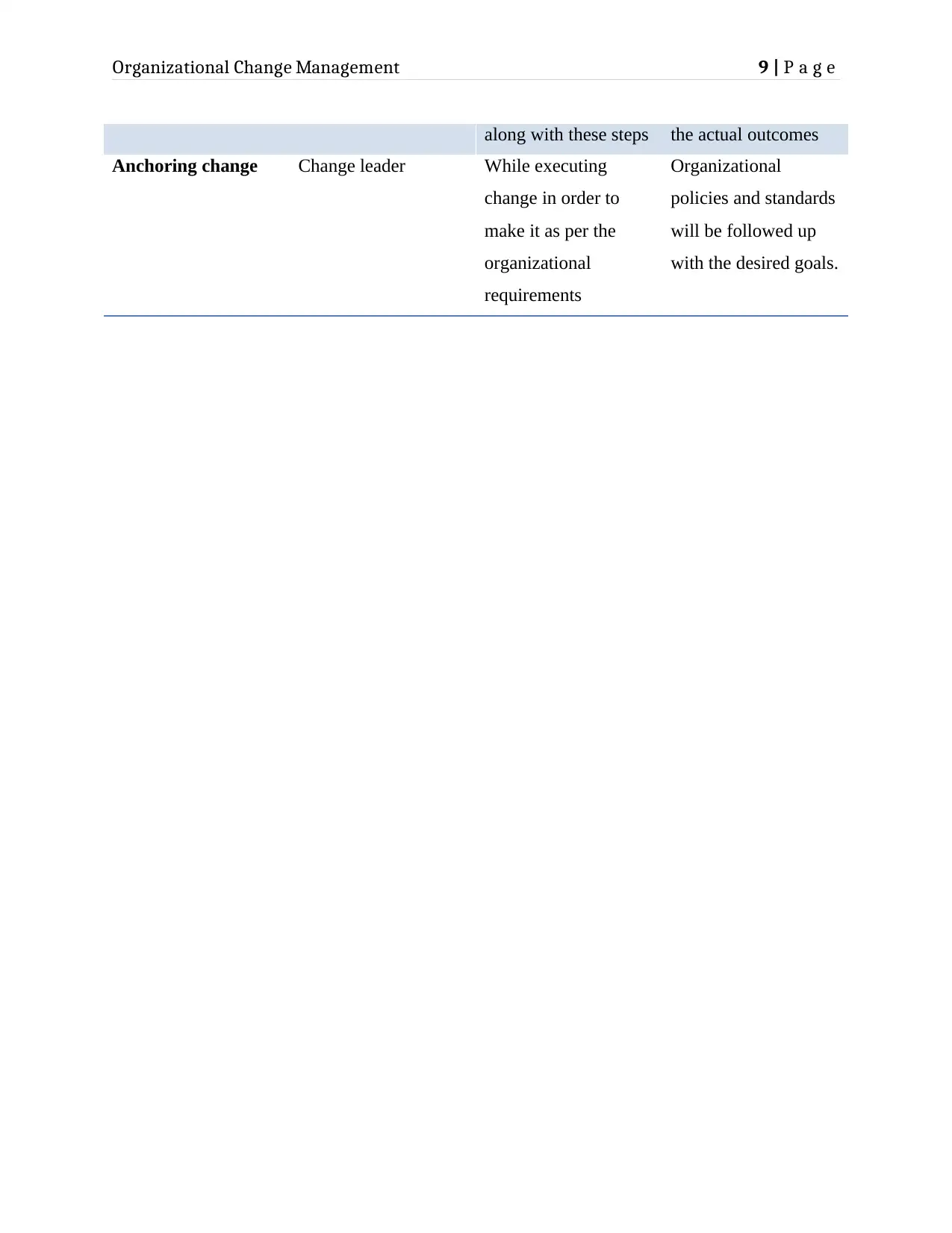
Organizational Change Management 9 | P a g e
along with these steps the actual outcomes
Anchoring change Change leader While executing
change in order to
make it as per the
organizational
requirements
Organizational
policies and standards
will be followed up
with the desired goals.
along with these steps the actual outcomes
Anchoring change Change leader While executing
change in order to
make it as per the
organizational
requirements
Organizational
policies and standards
will be followed up
with the desired goals.
Paraphrase This Document
Need a fresh take? Get an instant paraphrase of this document with our AI Paraphraser
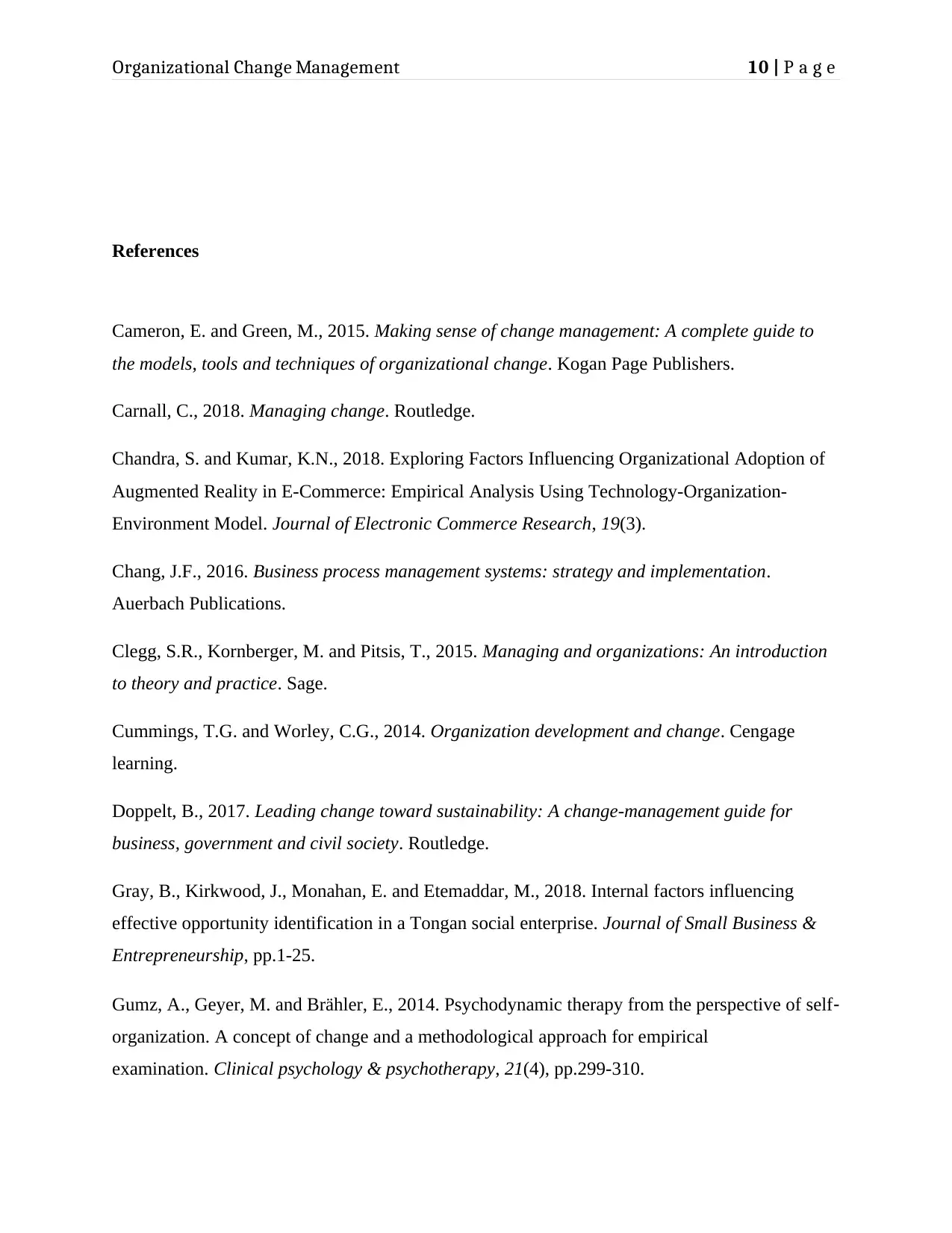
Organizational Change Management 10 | P a g e
References
Cameron, E. and Green, M., 2015. Making sense of change management: A complete guide to
the models, tools and techniques of organizational change. Kogan Page Publishers.
Carnall, C., 2018. Managing change. Routledge.
Chandra, S. and Kumar, K.N., 2018. Exploring Factors Influencing Organizational Adoption of
Augmented Reality in E-Commerce: Empirical Analysis Using Technology-Organization-
Environment Model. Journal of Electronic Commerce Research, 19(3).
Chang, J.F., 2016. Business process management systems: strategy and implementation.
Auerbach Publications.
Clegg, S.R., Kornberger, M. and Pitsis, T., 2015. Managing and organizations: An introduction
to theory and practice. Sage.
Cummings, T.G. and Worley, C.G., 2014. Organization development and change. Cengage
learning.
Doppelt, B., 2017. Leading change toward sustainability: A change-management guide for
business, government and civil society. Routledge.
Gray, B., Kirkwood, J., Monahan, E. and Etemaddar, M., 2018. Internal factors influencing
effective opportunity identification in a Tongan social enterprise. Journal of Small Business &
Entrepreneurship, pp.1-25.
Gumz, A., Geyer, M. and Brähler, E., 2014. Psychodynamic therapy from the perspective of self‐
organization. A concept of change and a methodological approach for empirical
examination. Clinical psychology & psychotherapy, 21(4), pp.299-310.
References
Cameron, E. and Green, M., 2015. Making sense of change management: A complete guide to
the models, tools and techniques of organizational change. Kogan Page Publishers.
Carnall, C., 2018. Managing change. Routledge.
Chandra, S. and Kumar, K.N., 2018. Exploring Factors Influencing Organizational Adoption of
Augmented Reality in E-Commerce: Empirical Analysis Using Technology-Organization-
Environment Model. Journal of Electronic Commerce Research, 19(3).
Chang, J.F., 2016. Business process management systems: strategy and implementation.
Auerbach Publications.
Clegg, S.R., Kornberger, M. and Pitsis, T., 2015. Managing and organizations: An introduction
to theory and practice. Sage.
Cummings, T.G. and Worley, C.G., 2014. Organization development and change. Cengage
learning.
Doppelt, B., 2017. Leading change toward sustainability: A change-management guide for
business, government and civil society. Routledge.
Gray, B., Kirkwood, J., Monahan, E. and Etemaddar, M., 2018. Internal factors influencing
effective opportunity identification in a Tongan social enterprise. Journal of Small Business &
Entrepreneurship, pp.1-25.
Gumz, A., Geyer, M. and Brähler, E., 2014. Psychodynamic therapy from the perspective of self‐
organization. A concept of change and a methodological approach for empirical
examination. Clinical psychology & psychotherapy, 21(4), pp.299-310.
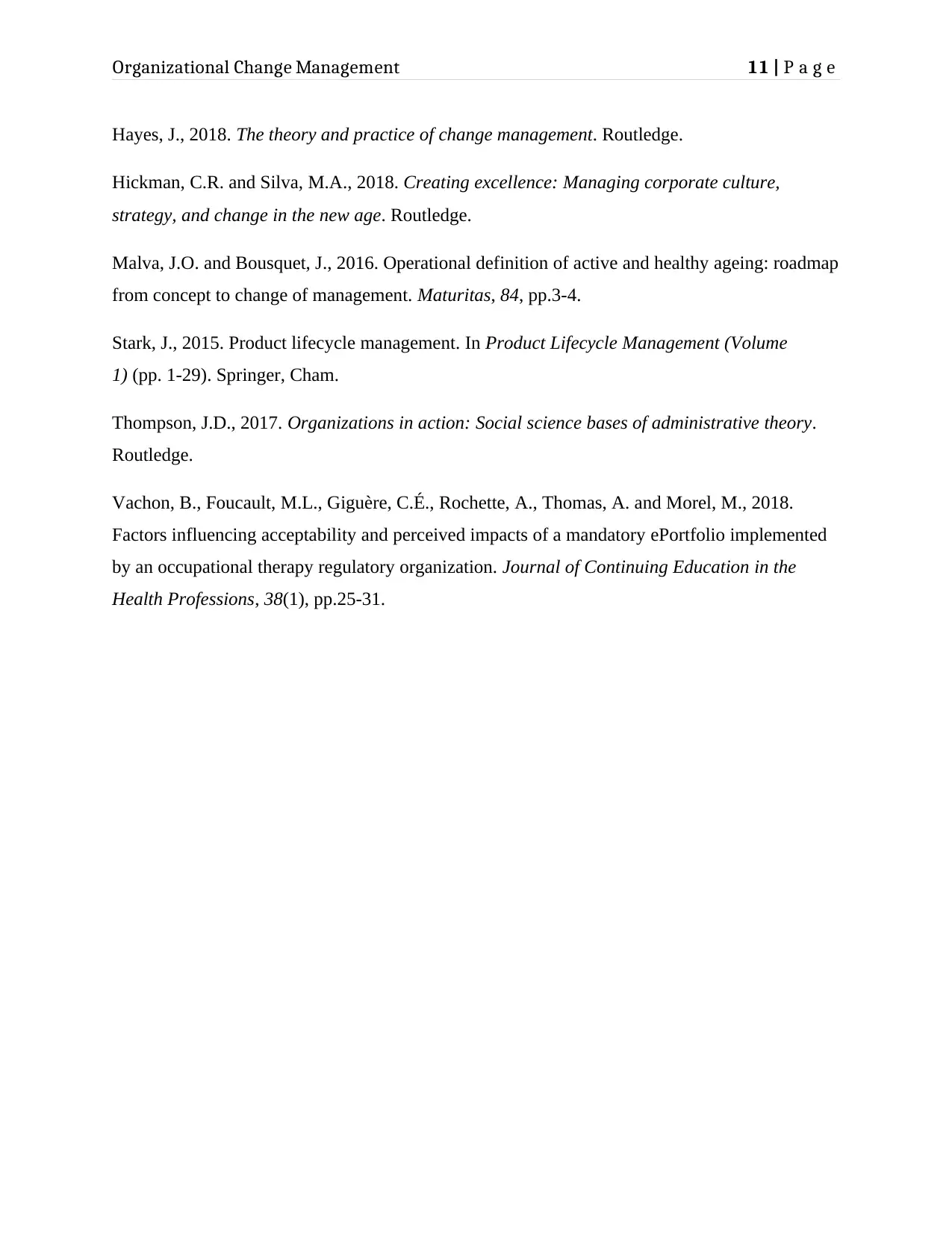
Organizational Change Management 11 | P a g e
Hayes, J., 2018. The theory and practice of change management. Routledge.
Hickman, C.R. and Silva, M.A., 2018. Creating excellence: Managing corporate culture,
strategy, and change in the new age. Routledge.
Malva, J.O. and Bousquet, J., 2016. Operational definition of active and healthy ageing: roadmap
from concept to change of management. Maturitas, 84, pp.3-4.
Stark, J., 2015. Product lifecycle management. In Product Lifecycle Management (Volume
1) (pp. 1-29). Springer, Cham.
Thompson, J.D., 2017. Organizations in action: Social science bases of administrative theory.
Routledge.
Vachon, B., Foucault, M.L., Giguère, C.É., Rochette, A., Thomas, A. and Morel, M., 2018.
Factors influencing acceptability and perceived impacts of a mandatory ePortfolio implemented
by an occupational therapy regulatory organization. Journal of Continuing Education in the
Health Professions, 38(1), pp.25-31.
Hayes, J., 2018. The theory and practice of change management. Routledge.
Hickman, C.R. and Silva, M.A., 2018. Creating excellence: Managing corporate culture,
strategy, and change in the new age. Routledge.
Malva, J.O. and Bousquet, J., 2016. Operational definition of active and healthy ageing: roadmap
from concept to change of management. Maturitas, 84, pp.3-4.
Stark, J., 2015. Product lifecycle management. In Product Lifecycle Management (Volume
1) (pp. 1-29). Springer, Cham.
Thompson, J.D., 2017. Organizations in action: Social science bases of administrative theory.
Routledge.
Vachon, B., Foucault, M.L., Giguère, C.É., Rochette, A., Thomas, A. and Morel, M., 2018.
Factors influencing acceptability and perceived impacts of a mandatory ePortfolio implemented
by an occupational therapy regulatory organization. Journal of Continuing Education in the
Health Professions, 38(1), pp.25-31.
⊘ This is a preview!⊘
Do you want full access?
Subscribe today to unlock all pages.

Trusted by 1+ million students worldwide
1 out of 12
Related Documents
Your All-in-One AI-Powered Toolkit for Academic Success.
+13062052269
info@desklib.com
Available 24*7 on WhatsApp / Email
![[object Object]](/_next/static/media/star-bottom.7253800d.svg)
Unlock your academic potential
Copyright © 2020–2025 A2Z Services. All Rights Reserved. Developed and managed by ZUCOL.





